In the fall of 1960, the ballistic missile submarine George Washington went to sea carrying the first Polaris missiles. The Navy's Special Projects Office had managed to take the entire system, submarine, missile and all, from paper to operational service in only four years. But just getting a submarine to sea with missiles in it wasn't enough.

An E-6 Mercury at the Tinker Air Show
One last hurdle to overcome was the problem of passing the launch order to the submarines. Water blocks most radio signals, and while previous submarines had been able to simply pick up messages intermittently, that was no longer good enough. One solution was to place a conventional antenna on a float, which would be towed behind the submarine. Another was to use low-frequency radio signals which could penetrate underwater. The standard method was to use Very Low Frequency (VLF) signals, which have wavelengths of 10 km or more. These transmitters are very large, and pass information at low rates (around 300 bits/sec), but the antenna can remain submerged, with the signals penetrating up to 50m underwater. Because of the size and vulnerability of the fixed transmitters, the USN developed another method of transmitting these signals, using an airplane to carry the antenna. The airplane, referred to by the term TAke Charge And Move Out (TACAMO), reels out a 10 km antenna, and flies in a tight circle, which results in 70% of the antenna being vertical and able to transmit a powerful VLF signal. This mission was originally performed by modified C-130s, but they were replaced in the late 80s with the E-6 Mercury, a derivative of the 707 airliner that also serves as backup command center for American land-based nuclear forces.
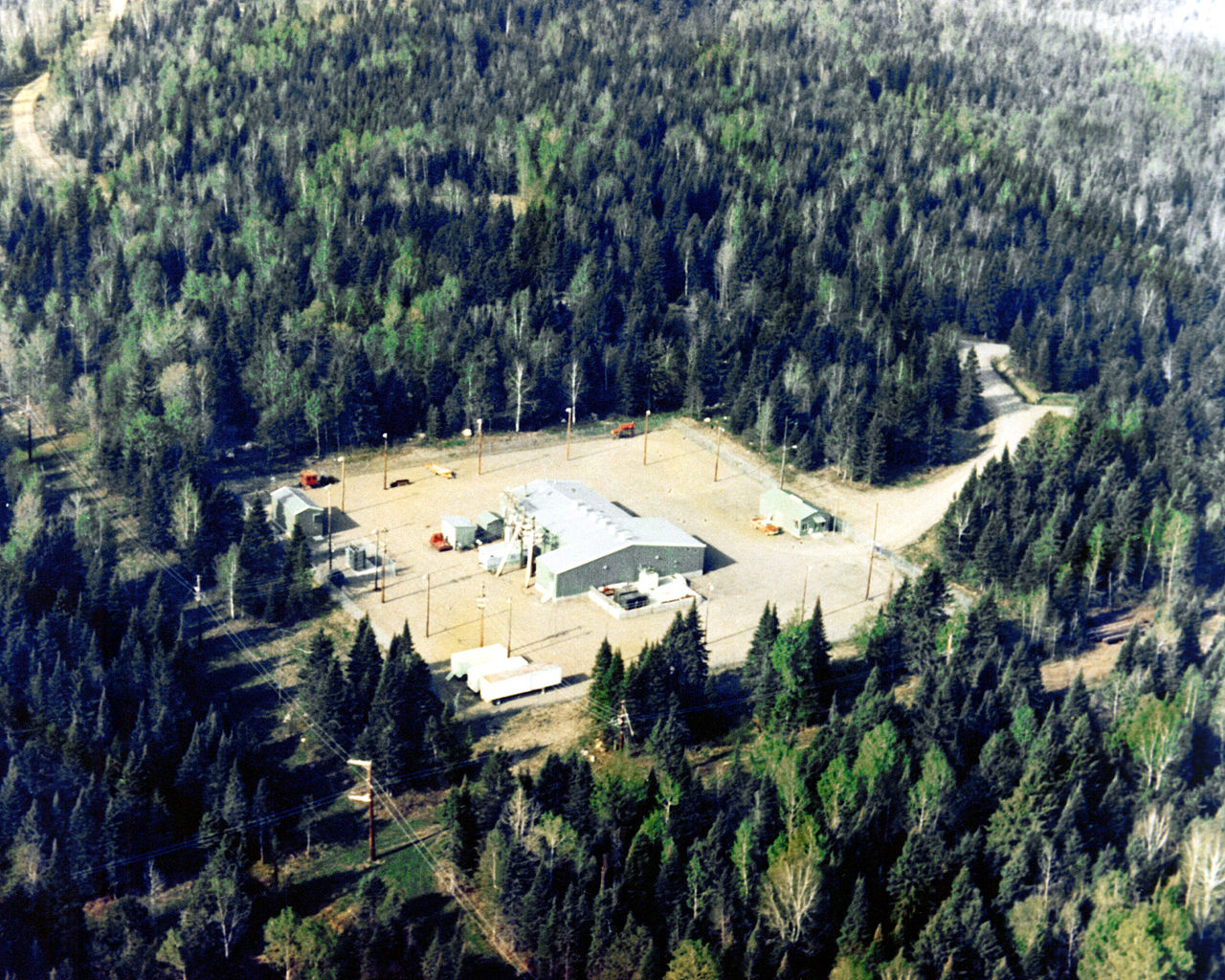
The ELF site at Clam Lake, Wisconsin
The problem with VLF is that it still requires the submarine, or some portion of it, to be quite close to the surface, which raises the risk of detection. The solution to this was to look for even longer wavelengths, in the Extremely Low Frequency (ELF) band. ELF wavelengths are measured in the thousands of kilometers, a length on the same scale as the diameter of the Earth, which means that building an appropriate antenna is very difficult. Only a few sites are suitable for the transmitters, as the right kind of ground is needed to allow them to use the Earth itself as part of an extremely inefficient antenna. The US built two, one in Wisconsin and one in Michigan, and it would take either site about 15 minutes to transmit a single 3-character group, but it could be picked up a submarine towing a trailing antenna almost anywhere in the world. Both sites were shut down by 2004, as TACAMO was thought to be a better option.1
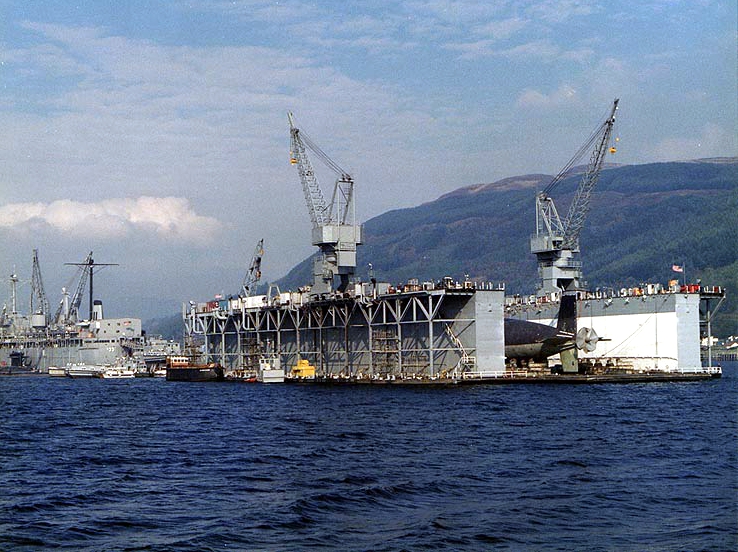
Floating drydock Los Alamos and submarine tender Simon Lake at Holy Loch
From the very start of the program, the Navy realized that keeping boats on station for as much of the time as possible would be important to keep the cost of Polaris down for a given number of warheads in range of their targets. The first and most radical method was to give each boat two crews, Blue and Gold.2 After each 70-day patrol, the crews would switch out, with the incoming crew taking the boat through a 30-day refit before heading out on their own patrol. This kept the crew from staying too long at sea, which would destroy morale and erode the force in the long term. Second, because of the limited range of Polaris, most of the refits were done at forward bases. The submarine tender Proteus was sent to Holy Loch, Scotland in 1961, and she was followed by other tenders not only there but also at Rota, Spain, and Guam. The submarines were technically based in the US, and the crews and their families lived stateside, the men flying to the forward base for the refit and the patrols.
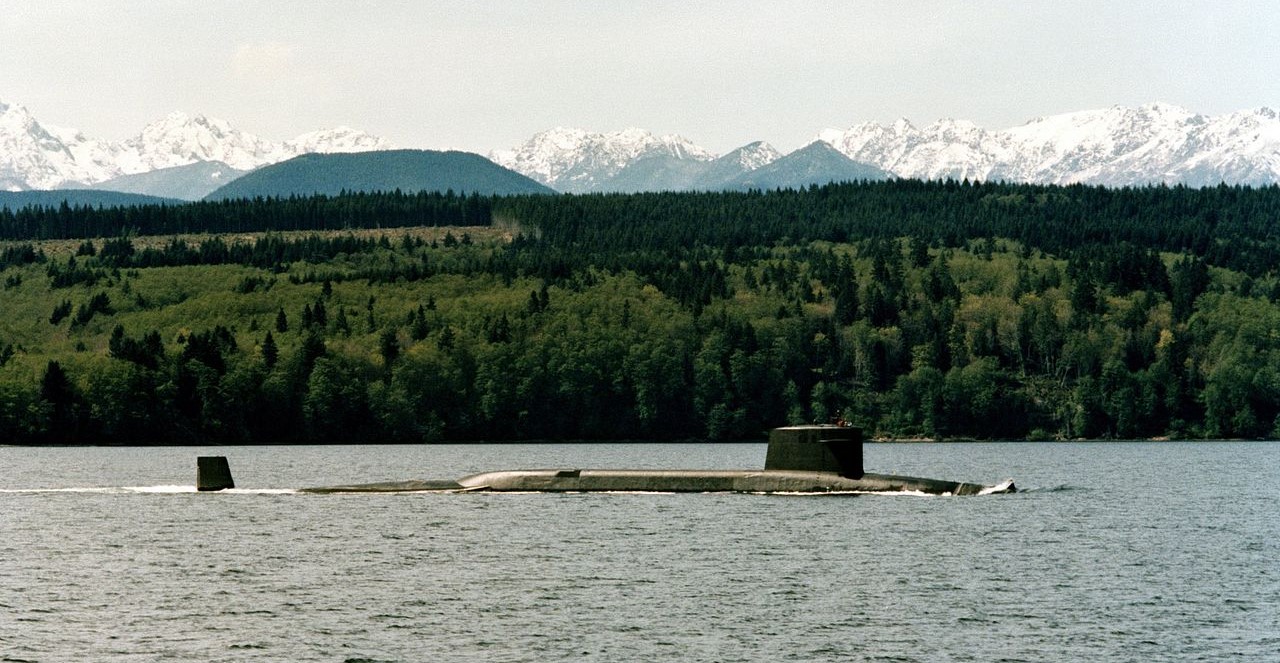
Sam Houston of the Ethan Allen class
Obviously, the five boats of the George Washington class were not enough for the Navy's mission, and they were quickly followed by five more built to the SCB 180 design that had originally been planned for the role and that had donated its missile compartment to the Washington design. These ships, the Ethan Allen class were quieter than the Washingtons due to their raft machinery, which also pushed up size by several hundred tons. But even before George Washington's maiden patrol, it was recognized that this design was too cramped, with inadequate space for habitability and maintenance. The result, which was also fitted with shock absorbers that increased the size of the missile tubes, was the Lafayette class, four of which had been ordered by July 1960. It was at this point that serious discussion began about how many SSBNs were actually needed. Some within the Navy and Congress proposed up to 100, but the number the Navy finally picked was 45, which would give 30 submarines on station at all times. This would let the Polaris force kill about 180 targets in the USSR and China, which should be about 80% of major industrial nodes that had been identified.3 Because of how concentrated Soviet industry was, a 25% cut in the Polaris force would only reduce target coverage to 70%, so Robert McNamara, Kennedy's secretary of defense, cut the target number to only 41 SSBNs, and the program became known as "41 for Freedom".

A cutaway of the Lafayette class
The Navy was quite happy with the Lafayette design, and so it ordered a total of 31 to this basic configuration. The last 12 were built with improved silencing and are often known as the Benjamin Franklin class. Wikipedia only counts the first 9 as the Lafayettes and has the middle 10 designated the James Madison class. This is apparently due to the introduction of improved missile tubes at this point in the production run, although this is not at all clear in most references, which tend to lump all three together. The last of the 41, Will Rodgers,4 was commissioned in April 1967, bringing to an end a program that had churned out 5 boats a year over the past 8 years, an incredible production rate, particularly given the 25 other nuclear submarines built during those years.
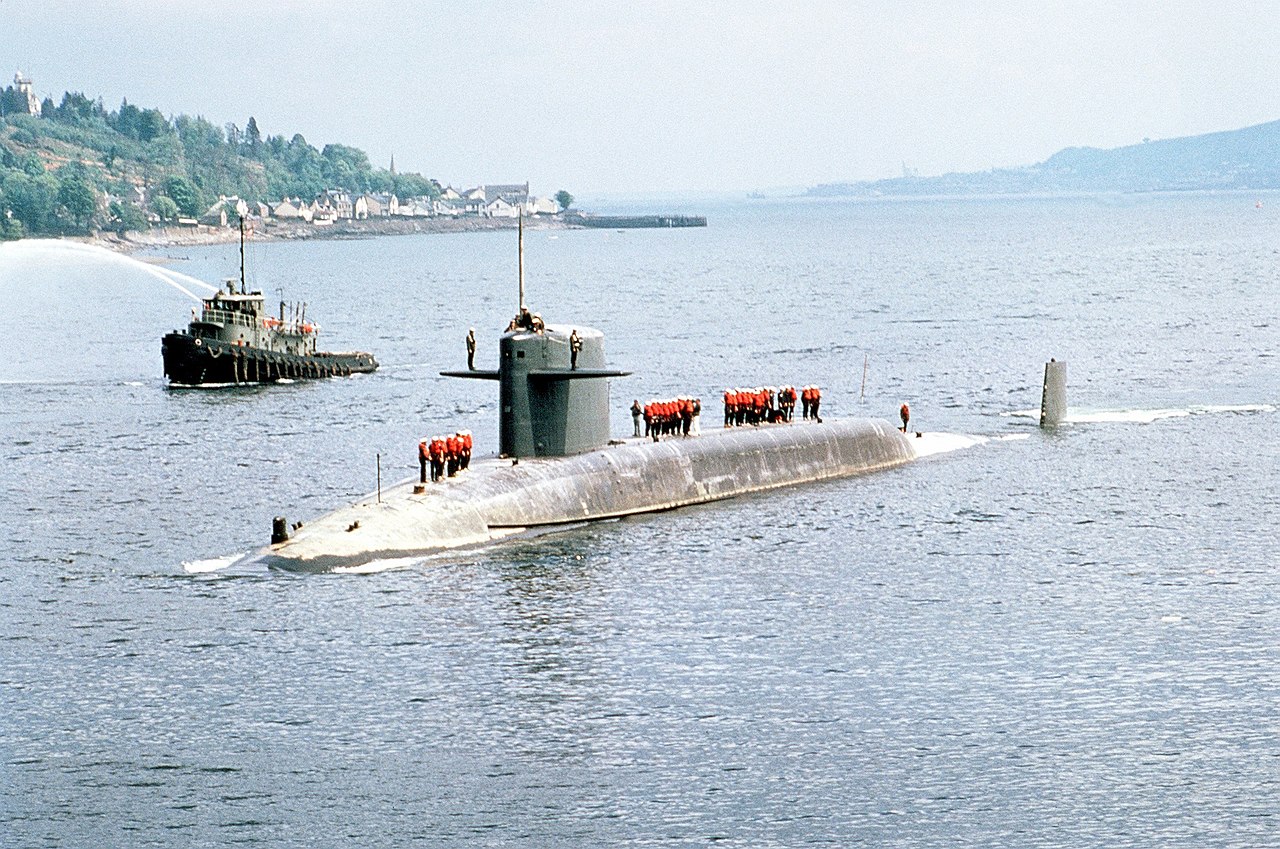
John C. Calhoun, one of the Lafayettes
Unfortunately, all of this activity had a catastrophic effect on the rest of the Navy's budget, which was ruthlessly cut to pay for the FBM effort. An early casualty was the Regulus II cruise missile program, which was axed in 1958 because Polaris was seen as cheaper. The next year, the Seaplane Striking Force followed suit, and shipbuilding programs likewise began to suffer badly, with major gaps appearing in the programs for aircraft carriers, surface combatants, and amphibious ships.5 The exact dollar value isn't clear, but the best numbers I can find suggest that submarine and missile procurement alone were estimated in 1960 to run to at least $11 billion,6 equivalent to approximately $100 billion in 2020. The actual cost was undoubtedly higher due to delays and inflation, to say nothing of the operating cost of the program. Unfortunately for the USN, just as it got out from under the cost of building the "41 for Freedom", US involvement in Vietnam began sucking up the defense budget, and the funding crunch continued to bite until the Reagan Administration's arrival in 1981.
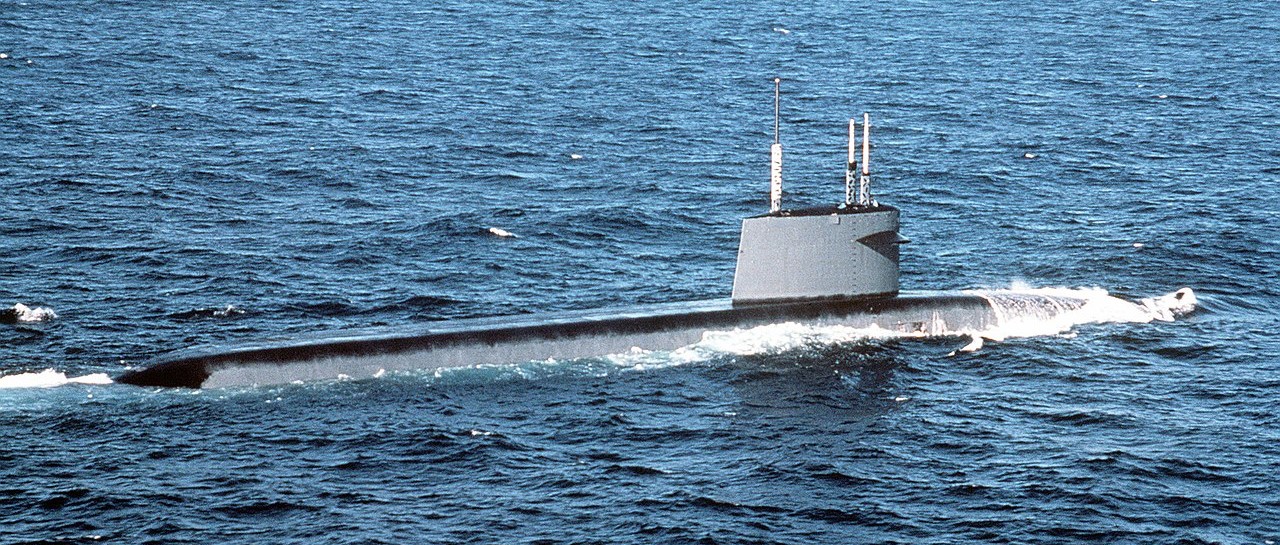
USS Alexander Hamilton7
But all of this ignores the biggest aspect of further development of Polaris. The A1 missile that George Washington carried on her first patrol was in many ways a prototype, unsuited for operational service in the hands of the regular navy, and many estimated it would only be about 50% reliable. Better missiles were on the way, and we'll take a look at them next time.
1 This was a much smaller system that had been originally proposed under Project Sanguine, a plan to turn 40% of Wisconsin into a giant nuclear-hardened ELF transmitter. ⇑
2 So named after the colors of the Naval Academy. ⇑
3 Each target was to be hit by two missiles for redundancy, and it was assumed that 20% would malfunction and 10% would be shot down. ⇑
4 This makes me think it was a good thing that the program was halted at 41 boats, as the "Great Americans" naming theme was clearly beginning to run a bit dry. I still am not sure exactly why the Navy needed to butter up the Oklahoma congressional delegation at this point, but hope to find out someday. Nor was Will Rodgers the only example of pandering in the program, including such luminaries as Mariano G. Vallejo and Simon Bolivar. And then there were Robert E. Lee and Stonewall Jackson, names we wouldn't consider using today. ⇑
5 It's worth pointing out that this looks set to recur over the next decade or so, as the construction of the Columbia class SSBNs is going to bite deep into the USN's shipbuilding budget. ⇑
6 Approximately equal to an entire year of the Navy's budget. ⇑

Comments
The question for me remains, why the hell don't we double crew everything? Or at least all the attack subs.
I suspect that you wouldn't get nearly the same boost in availability from doing this with most other types of ships. An SSBN's mission is pretty simple. Go out, don't get detected, push the button if ordered. But anything else has a lot more missions and needs a lot more working up. The general rule is that you spend a third of the time in the yard, a third of the time working up, and a third of the time on deployment. The yard time is fixed, and the SSBNs get it to. But they can minimize the working-up bits, which otherwise will destroy any dual-crew system.
Well, almost. There have been more experiments with the concept in recent years, although the majority are cases where you'll forward-base a ship and swap the crew out with the crew of a ship back home. I know it's been done with minesweepers in the Persian Gulf, for instance. It can work OK, but I've heard that there tend to be problems with people not taking care of the ship very well because it isn't theirs. There was also talk of doing this with LCS, although I can't remember how far it went.
Sorry, but what's a "working up"?
It's the process of taking a bunch of guys with individual skills and turning them into the crew of a warship. Remember that a typical tour in the US military is 2-3 years, and if you're deploying every 18 months, you're going to have a lot of turnover. (This is probably another reason SSBNs get away with it. They're doing deployments often enough it's a lot easier to fold in new people.) So you have to get new people trained, and people who have experience rotating in, and you need to get them familiar with the specific ship, and working together as a team. Then you have to take that team and integrate it with the rest of the battle group. Rule of thumb is that the process takes 6 months, although that seems to be honored in the breach quite often of late.
@bean
That's the answer I often hear, but it's always left me unsatisfied. I can see that for surface ships, doing a 6 month or even year deployment isn't so bad. You do port calls, you can go up on deck, etc. 6 months in a tube would drive people mad, so I see why boomers have to deploy for shorter time periods, and thus need double crews, but attack submarines have a pretty similar deployment pattern and suite of kit, you'd think they'd do the same thing there.
Dual crews works on SSBNs because the off-boat crew has lots of trainers and support systems to make it work.
One reason we don't dual-crew everything else is because it's too hard and expensive to make/retain nukes (and to some extent submariners in general). See my previous comments on the problems.
As far as doing it on surface ships...the PCs, LCS, and MCMs do it. LCS and PCs pull it off okay, although LCS is a disaster no matter what and PCs have a very limited mission set and area of responsibility. MCMs do it terribly. But MCMs do everything terribly because they are bastard children, unloved and unwanted; their failure in this case may not be their fault. I know it was tried on three DDGs (crews rotated between them) in the early 00s, and it was...less than ideal. Big issue was ownership of the hulls (eg the tyranny of the commons-no one took care of the ships so they suffered a lot more materiel failures than the norm). Theoretically that should be overcomeable, but no one seems eager to try it again.
@blackshoe
Either dual crewing saves money or it doesn't, and I can't see how two crews and one ship ever ends up being more expensive than two crews and two ships, though given the state of USN procurement, you never know.
I suspect that it dual-crewing may save money in some cases but not others. For SSBNs, your measure of utility is fairly straightforward (missiles on patrol) and as such, removing crew availability constraints is going to reduce cost significantly. But figuring out numbers for other ships is harder, and one important factor in having hulls is surge capability. Two crews/one hull means you'll never have more than one hull on the line. Two crews/two hulls is more expensive, but gives you the opportunity to have two hulls forward, which seems like it could be important for most combatants.
Also worth pointing out that the fraction of the cost which is crew is going to change with type of combatant. SSBNs are crazy expensive, so spending more on crew to save on procurement makes a lot of sense. But DDGs are less crazy expensive, so you're saving less on procurement by spending more on crew. Also, not all ships have the same crew. A $5 billion Columbia with a 150-person crew is a different matter than a $2 billion DDG with a 300-person crew. Even if it's more expensive to keep submariners, it's not 5 times as expensive. The LCS (planned to be 3 crews/2 hulls/1 deployed) is a $550 million ship with a 40-man crew.
I've been given to understand that the land forces have been "falling in" on equipment that's already in-theater (and would be difficult to transport back and forth as units rotate in and out). And that there is a problem with PMCS not being carried out properly because "that's a problem for the next unit. I sure wouldn't want to be those guys."
@cassander:
Not really following here. Note that I didn't say dual-crews was cheaper for SSBNs, just that it worked, and that bean noted the original point of dual-crewing was to maximize the amount of time you could keep missiles on station. It was probably more expensive...but worth it to keep nuclear deterrent ready and available.
Though, there are extra costs associated with being an SSBN (namely, nuclear missiles are super-expensive, and also the costs to silence them are ridiculous). Because SSBNs are single-mission platforms, they end up being highly-engineered for that mission; SSNs are more multi-mission so you accept some sacrifices (and also you know you're going to build more so you're going to keep the price down anyway). Additionally, there's the factor that you can't actually build more SSBNs, since they are limited by treaty (I mean, of course, you could! But it would be really bad and upset the Russians and still be really expensive and it's really not worth it anyway). With SSBN (and -GNs, as well), you're paying for the costs of keeping 2xcrews for 18 boats. At the Wikipedia nr of 155 crew per boat, you're coming up with 2800 or so sailors. Assuming we buy all the Virginia-class we say we're going to buy (66), that number is more than three times higher. That's...a lot of extra people.
I guess you could build worse SSBNs that would be cheaper to build (but more likely to get sunk) and thus even things out. If you really wanted to, I guess?
SSBNs are uniquely single-purpose, and that means their operations are going to look different from other types of ships. If the goal is 30 boats on station at all times, then you're going to need either 45 boats and 90 crews, or probably something like 80 boats and 80 crews. The former is obviously cheaper, but it also means you will never have more than 30 boats on station. This is fine for SSBNs, but that isn't how most other types of ships operate. They're inherently more multi-purpose (which, incidentally, has caused a lot of problems with more strict DoD analysis requirements) and as such, your goal isn't just "have X on station at all times". Sure, there's a number you expect to need available in peacetime, but you'd like some flexibility in case you have a crisis and need more ships. Note how many carriers participated in operations against, say, Iraq. No way to do that without hulls.
"Air is free and steel is cheap" And even naval electronics suites are cheap compared to the crew of a modern man'o'war.
The answer to "why are SSBNs different" seems to be "because SLBMs are priceless" more than anything else. At least under current thinking.
Isn’t part of the issue for SSBNs the strategic arms limitation treaties? The US is limited to a certain number of missile tubes, so it’s most valuable to have as many of those missiles at sea as possible at any given time. Double crewing accomplishes that.
Meanwhile DDGs are not treaty limited, so idling a hull while the crew recuperates is less of a concern.
That may be the case today, but it definitely wasn't in the late 50s/early 60s when the Blue/Gold system was set up. There were some arms control treaties at the time, but that was stuff like the Partial Test Ban. I don't think system numbers were limited until the 70s or 80s.